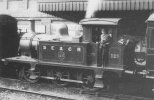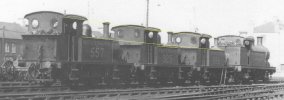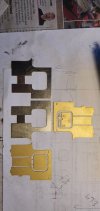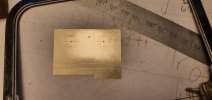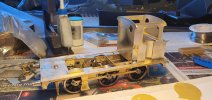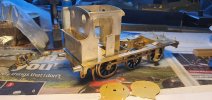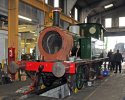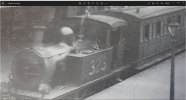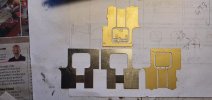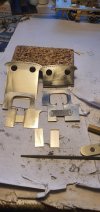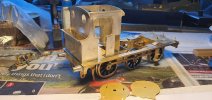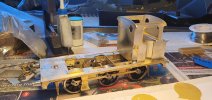Nick Dunhill
Western Thunderer
On inspecting the etches I noticed that the footplate was continuous under the boiler to the rear of the smoke box and that the chassis was a one piece fold up jobby.
The coupling rods were etched in brass(!) and not jointed, which is essential for a model with suspension.
I roughed out some boss overlays from scrap nickel silver sheet and re jigged the rods to look a bit more realistic.
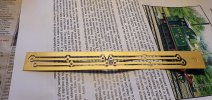
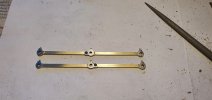
The finished loco will be in SECR livery and feature inside motion IF the budget would allow. The cross members on the chassis etch would have to go therefore and be replaced with ones in the correct place if inside motion was to be fitted. Also I would have to cut a hole in the footplate to reveal the motion, and fill some random others.
Here’s the chassis after a bit of a rework. You can see that I have made all the stays in the prototypical places and added the front and sides of the ash pan. The ash pan was scratch built as there’s nowt for it in the kit and you can see the gearbox through the lightening holes In the frames.
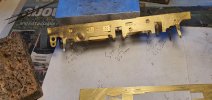
I turned to the footplate and reduced the height and length of the valences and attached them to the underside of the footplate along with the buffer beams. I soldered 1.5 x 1.5 mm L section brass to the backs of the valences to keep them straight and aid with fixing to the footplate. None of the above parts have any registration slots or grooves to locate them. I then went to town a bit adding all the angle that would normally be under the footplate holding it all together.
I cut the footplate away under the boiler where it shouldn’t be!
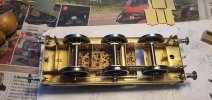
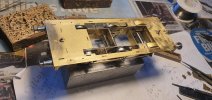
You can see that I made and modified some CPL SECR couplings. The shank of the rear hook has been extended to fit the drag box and the front one shortened. I fitted the cast white metal buffer shanks with their turned heads.
Tomorrow I plan to scratch build a cab and bunker as the etches supplied are dimensionally wrong….by a lot. I saw a thread elsewhere where the builder couldn’t fit the BR number onto the bunker as it was too short. The bunker should be 17 mm long from the rear to the door opening and the etch is 14 mm so I’m not surprised. The cab front and rear and the bunker rear are 2 mm too narrow and the cab should be 3 mm longer. I rang Warren Haywood and he said that he wouldn’t be able to paint all the correct borders and boxes of lining onto the cab sides and then fit the numbers and works plate.
Methinks there won’t be enough in the budget for inside motion. Pity, it’s a cute little loco.
The coupling rods were etched in brass(!) and not jointed, which is essential for a model with suspension.
I roughed out some boss overlays from scrap nickel silver sheet and re jigged the rods to look a bit more realistic.


The finished loco will be in SECR livery and feature inside motion IF the budget would allow. The cross members on the chassis etch would have to go therefore and be replaced with ones in the correct place if inside motion was to be fitted. Also I would have to cut a hole in the footplate to reveal the motion, and fill some random others.
Here’s the chassis after a bit of a rework. You can see that I have made all the stays in the prototypical places and added the front and sides of the ash pan. The ash pan was scratch built as there’s nowt for it in the kit and you can see the gearbox through the lightening holes In the frames.

I turned to the footplate and reduced the height and length of the valences and attached them to the underside of the footplate along with the buffer beams. I soldered 1.5 x 1.5 mm L section brass to the backs of the valences to keep them straight and aid with fixing to the footplate. None of the above parts have any registration slots or grooves to locate them. I then went to town a bit adding all the angle that would normally be under the footplate holding it all together.
I cut the footplate away under the boiler where it shouldn’t be!


You can see that I made and modified some CPL SECR couplings. The shank of the rear hook has been extended to fit the drag box and the front one shortened. I fitted the cast white metal buffer shanks with their turned heads.
Tomorrow I plan to scratch build a cab and bunker as the etches supplied are dimensionally wrong….by a lot. I saw a thread elsewhere where the builder couldn’t fit the BR number onto the bunker as it was too short. The bunker should be 17 mm long from the rear to the door opening and the etch is 14 mm so I’m not surprised. The cab front and rear and the bunker rear are 2 mm too narrow and the cab should be 3 mm longer. I rang Warren Haywood and he said that he wouldn’t be able to paint all the correct borders and boxes of lining onto the cab sides and then fit the numbers and works plate.
Methinks there won’t be enough in the budget for inside motion. Pity, it’s a cute little loco.

